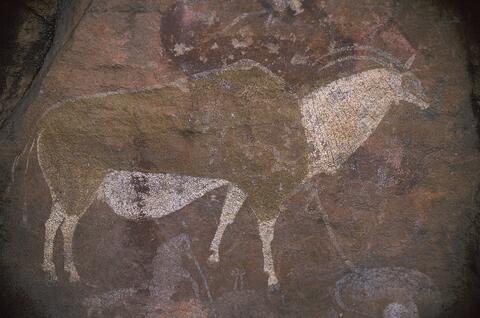Identificatie
referentie code
Titel
Datum(s)
- 20/04/2002 (Vervaardig)
Beschrijvingsniveau
Omvang en medium
Context
Naam van de archiefvormer
Biografie
Brief description of art: Two sites SW facing in a ravine, which is upstream from the deserted buildings, marked as RSA TYG1. The upper site is sparsely painted containing only a few figures. It was neither photographed nor sketched.
RSA TYG1 has 7 panels. Panel 1 contains a depiction of a large, clear person, outlined in white, bending forward. There is also a depiction of a woman holding a digging stick.
Panel 2 contains 4 ostrich, a quagga, and 2 eland. Large bellies are noticeable on the 2 eland and quagga.
Panel 4 contains a depiction of what Woodhouse has labeled a beehive, but there are no bees painted on the rock. A small white antelope is also depicted.
Panel 7 is in a very sheltered corner and is the best-preserved panel. There is a large group scene of about 16 figures all in red. Eight of these figures are outlined in white. The 6 largest figures, average 300-310mm in height. At least 6 figures have 'headdresses' in black with brown/cream dots on them. Six of the figures hold sticks with inverted black triangles on the end that are flecked with dots. The individual fingers of the figures are drawn. None of the figures have penises and 1 figure is clearly female. In the centre of the panel is what appears to be a man/eland combination figure although this is unclear. Superimposed on the left hand part of this group are 10 white figures, most of which are running.
Digging sticks.
Naam van de archiefvormer
Naam van de archiefvormer
Biografie
archiefbewaarplaats
Geschiedenis van het archief
Directe bron van verwerving of overbrenging
Inhoud en structuur
Bereik en inhoud
The eland was the first animal that the San trickster deity, /Kaggen created and it remained his favourite.
The eland is the largest of southern African antelope and is much desired for its meat and fat. The San say that all other animals are like servants to the eland.
The importance of this animal is shown in the great variety of postures and perspectives. It is depicted running with tail outstretched, with uplifted head smelling the wind, and upside down, presumably dead. The eland is also depicted from the front or from the back, and even from above.
The eland appears in four important San rituals it is the most carefully depicted antelope in both rock paintings and engravings: Trance dance, boy's first kill, girl's puberty and marriage. It is believed that eland fat contains a lot of potency and in a trance dance shamans aspire to possess eland potency.
Waardering, vernietiging en slectie
Aanvullingen
Ordeningstelsel
Voorwaarden voor toegang en gebruik
Voorwaarden voor raadpleging
Voorwaarden voor reproductie
Taal van het materiaal
- Engels
Schrift van het materiaal
Taal en schrift aantekeningen
Fysieke eigenschappen en technische eisen
Original size: 35mm

